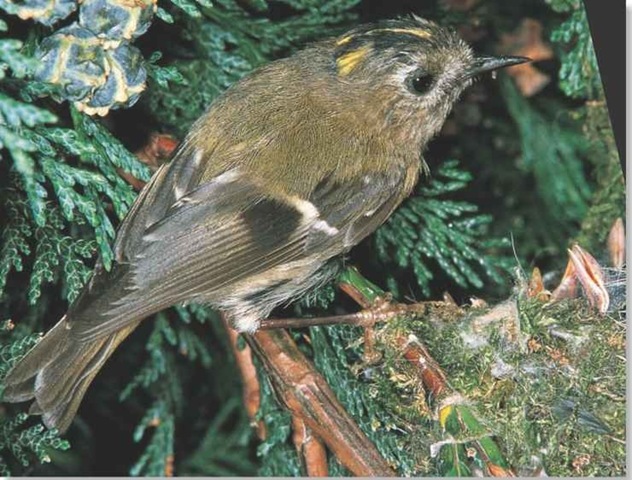ORDER
Passeriformes
FAMILY
Sylviidae
GENUS & SPECIES
KEY FEATURES
Europe’s smallest bird, dwarfed even by . a sparrow
Hunts tiny insects and spiders in treetops, where it flutters, hovers and climbs to track down prey Always on the move, it must feed at least 90% of the time each day in winter just to stay alive
WHERE IN THE WORLD!
Breeds from Britain and Ireland east across Europe, southern Siberia and parts of central Asia to Japan; northern populations go southward for winter
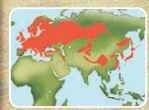
Lifecycle
One of the most hyperactive of all birds, the goldcrest spends its life in constant quest for food. In winter, it can’t survive for more than an hour during the day without feeding.
Habitat
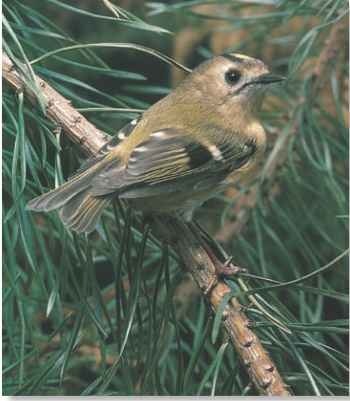
A High flier Goldcrests spend their lives in the forest canopy.
For most of the year, the goldcrest is rarely found far from coniferous trees, especially spruce and fir: It breeds in all types of coniferous woodland, from the vast forests of Scandinavia and Siberia to commercial forestry plantations, scattered woods on heathland and even city parks and gardens. It breeds in lowlands and mountainous areas, occurring up to 7,260′ in Switzerland.
In winter, when there is less choice of habitats, it also lives in deciduous woodland, hedges, areas of scrub or undergrowth, and even reedbeds. Populations from the extreme north of the species’ range migrate southward to more temperate regions in late autumn, as persistent ice and frost kill off the goldcrest’s insect prey leading to its certain starvation if it stays put.
Food & feeding
As befits Europe’s smallest bird, the goldcrest specializes in hunting the smallest types of insect and spider, which are often ignored by larger insect-eating birds. It picks its prey from fine twigs and pine needles high in the crowns of conifers, only descending to feed among lower branches or bushes in winter: The goldcrest consumes huge numbers of aphids in the warmer months, and also snaps up caterpillars, flies, moths and mites.
Without pausing to rest, the goldcrest quickly searches every part of a twig, hanging upside down to look underneath them to examine any crack or hole that might hide prey. Insects trapped in spiders’ webs make an easy meal. The goldcrest also hunts insects on the wing, darting away from its perch and opening its bill to snatch them in air: By using A Huge appetite several techniques, the goldcrest The goldcrest eats maximizes its feeding success. thousands of insects a day.
In winter, the goldcrest must find an insect or spider every 2.5 seconds to maintain its bodyweight.
On rare occasions, hungry goldcrests have searched over the clothes of astonished humans for food.
Bird-hunting hawks, such as the sparrowhawk, tend to ignore the goldcrest — it is not worth their time and effort chasing such tiny prey.

Conservation
The goldcrest is common across most of its range. Its only significant threat is natural: in severe winters, it undergoes huge population crashes and becomes scarce in the most hard-hit regions of its range, but is able to recover within a few years. Recently, the goldcrest has benefited from the spread of commercial spruce forests in Scandinavia and Scotland.
Breeding
Like most other small perching birds, the goldcrest has a short lifespan; most individuals do not reach their first birthday. To cope with its brief life expectancy it lays a large clutch of 7-10 eggs and raises two broods each year, one after the other, which ensures that some chicks will survive to breed the next year.
In spring, the male sings to defend his breeding territory and attract a female. To court her, he raises his glowing yellow crest in a dramatic display. The pair builds a nearly closed-up nest of finely woven moss and lichens, bound together with spiders’ webs. The female incubates the eggs alone for two weeks. The tiny, helpless chicks are fed insects during their three-week stay in the nest: a demanding task shared by both parents.
THE FAMILY TREE
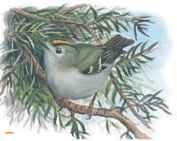
Search…
A goldcrest works harder to find food when it has a family to feed.
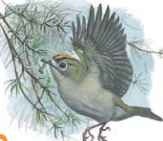
Hover…
Spotting a caterpillar on the tree’s twigs, the gold-crest hovers in midair and s eizes the juicy prize.
Behavior
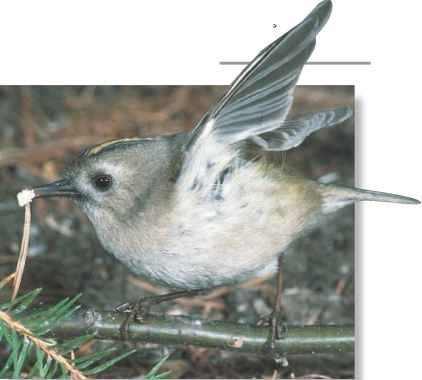
Balancing act The goldcrest can run along fine twigs, using its wings for balance.
The small goldcrest is often overlooked, but it is surprisingly fearless and may approach to within 3′ of humans in winter It-is seldom heard, since its high-pitched zi-zi-zi call is beyond the hearing of most humans.The male’s courtship and territorial song consists of a frequently repeated series of treble notes that ends with a sudden flourish.
In winter, the goldcrest forms small feeding parties, which may defend exclusive territories, but usually join up with bands of chickadees, nuthatches and creepers in the ceaseless and desperate search for food. By gathering together, the birds increase their chances of finding good food sources, which can be shared by all.
The goldcrest hops and jumps among branches and twigs in a jerky, almost frenetic fashion, rather like a wren, and has very fast-whirring wings.
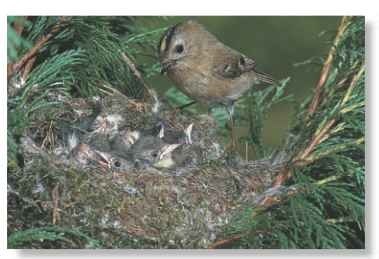
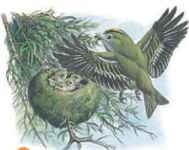
Return…
With a full bill, the goldcrest returns to its nest, which is barely large enough for its fast-growing brood.
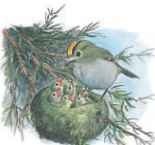
Feed
Chicks gape their bills to show bright-orange skin inside, which stimulates parent to feed them.
PROFILE
Goldcrest
Beautifully camouflaged in its lofty treetop home, the minuscule goldcrest is almost invisible to humans as it moves acrobatically in search of prey.
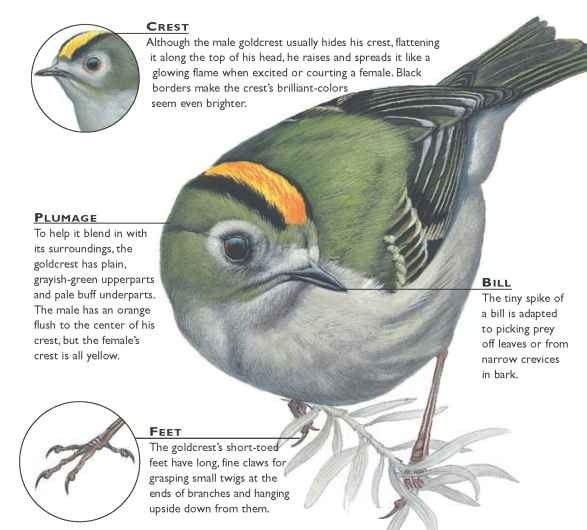
Creature comparisons
Competing with the goldcrest for the title of smallest European bird, the fractionally heavier firecrest (Regulus ignicapillus) is named after the vibrant, orange-red streak along the center of its crest.The firecrest is
more easily distinguished from its relative by bolder patterning on its head plumage: a black stripe passes across the eye and a thick white one lies above it.The goldcrest has pale feathers surrounding its pure black eye.
Both species are very active, and both inhabit woodlands, although the firecrest does not share the goldcrest’s preference for coniferous trees.
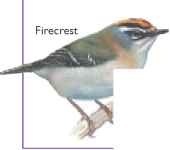
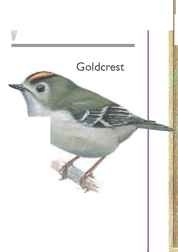
| vital | |
| statistics | |
| Weight | 0.14-0.28 oz. |
| Length | 3.5″ |
| Wingspan | 5.5-6.2″ |
| Sexual Maturity | 1 year |
| Breeding Season | April-August |
| Number of Eggs | 7-10 in each clutch |
| Incubation Period | 15-17 days |
| Fledging Period | 17-22 days |
| Number of Broods | Up to 2 each year |
| Typical Diet | Tiny spiders, insects (mainly flies, aphids, caterpillars) |
| Lifespan | Up to 7 years, but usually less than 1 year |
Related species
• The goldcrest belongs to a group of 6 tiny birds, known as kinglets, which includes the firecrest, Canary Islands goldcrest, Taiwan firecrest and ruby- and golden-crowned kinglets. They are often classed as subfamily (Regulinae) of the warbler family, Sylviidae, with 400 or so members: including whitethroats, leaf warblers and prinias. All are active, insect-hunting birds.
